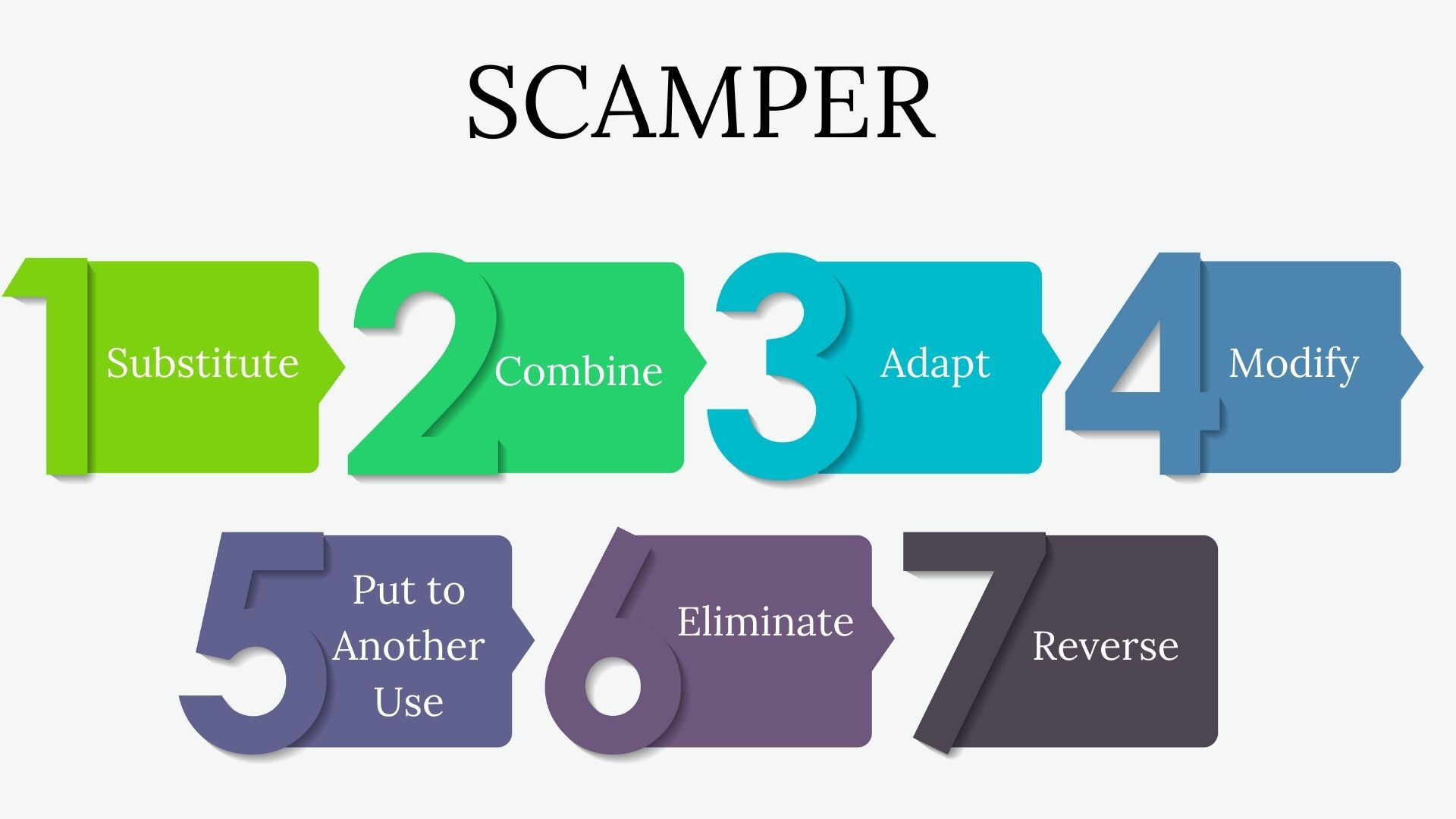
What is SCAMPER? How Does SCAMPER Solve Your Problems?

SCAMPER is a powerful creativity technique that helps solve problems by exploring seven key steps: Substitute, Combine, Adapt, Modify, Put to Another Use, Eliminate, and Reverse/Rearrange It is a proven method that can spark new ideas and unleash your creativity
The SCAMPER technique is a valuable tool for generating creative ideas and innovation. It involves seven key steps - Substitute, Combine, Adapt, Modify, Put to another use, Eliminate, and Reverse - that can be applied to improve any product or service. Whether you are facing personal or professional challenges, SCAMPER can help you find the most suitable solutions. By emphasizing that new ideas are often modifications of existing ones, this technique can supercharge your design process and turn your ideas into innovative solutions.
Introduction to the SCAMPER Techniques
Welcome to the world of SCAMPER techniques! In this post, we will explore how these techniques can be utilized to achieve effective and result-oriented outcomes. Let's dive right in and discover the power of SCAMPER.
Creating something new is a common goal for any business or process. However, the process of innovation is often accompanied by challenges and obstacles. It is during these moments of difficulty that true innovation arises, pushing us to think outside the box and find new solutions.
We require a problem solver who can devise effective solutions during this phase. And what if we had access to a tool that could assist us in accomplishing this task? Fortunately, such a tool exists in the market, and it goes by the name of 'Scamper.' Now, let us delve deeper into the acronym 'SCAMPER.'
What is Scamper?
One can utilize a range of problem-solving techniques, including Hurson’s thinking model, reversed brainstorming, Lego Serious Play, and six hats of critical thinking. Another effective tool for facilitating innovation and creativity is the scamper method, which was developed by Bob Eberle in the 1970s. This approach involves utilizing checklists and asking targeted questions to approach problem-solving from a fresh perspective.
By filling out the questionnaires, you will receive solutions to your problems through the Scamper system. These solutions can help you enhance your services and generate innovative ideas for your business. The name Scamper is derived from the specific steps involved in creatively solving problems within the process.
S: Substitute
C: Combine
A: Adapt
M: Modify/Magnify
P: Put to Another Use
E: Eliminate
R: Reverse
Role of Scamper in the Creative Processes
Scamper is a valuable tool for solving both simple and complex creative problems. By utilizing Scamper, the process can become more efficient and effective. This brainstorming technique encourages the improvement of existing methods, reducing the waste of resources and maximizing their potential. With its ease of use and implementation, it's no surprise that Scamper has gained significant popularity.
Scamper offers a fresh approach to critical thinking by allowing for flexibility in problem-solving techniques. This innovative tool encourages creativity and prompts users with thought-provoking questions to uncover effective solutions. By exploring various forms of thinking, Scamper provides a valuable resource for boosting creativity.
How Does SCAMPER Solve Your Problems?
Scamper uses seven primary steps to solve any problem. These are the same steps whose initials form the word ‘Scamper.’ Here is a list of them, along with their details.
1. Substitute
Focusing solely on certain aspects of a process can hinder progress, resulting in unnecessary steps or parts in a machine. To overcome this, substitution can be utilized to replace inefficient components with more productive alternatives, prioritizing the overall outcome rather than individual components.
Some of the question whose answers will help you in optimizing the usability of this step of SCAMPER technique-
Substitute Steps Questions in SCAMPER Technique
What assets or materials would you be able to substitute for upgrading the item?
What procedure or item would you be able to use?
Can you use different materials or fixings?
Can you change its shading, sound, smell, or harshness?
Can you change its shape?
Which rules would you be able to substitute or change?
Is it conceivable to supplant somebody included?
Can you use the thought or idea somewhere else?
What would occur if you altered your demeanor or emotions towards the item?
2. Combine
Combining various elements of a product or service can often result in design challenges. This is where the combination step of the Scamper tool becomes essential. According to design and creative experts, this step is crucial for success. By merging two unique ideas, a stronger concept can be formed, resulting in new products or technologies that enhance the brand's value in the market. Creativity is key in this step.
Key questions that should be answered in the Combine step of SCAMPER technique-
Combine Step Questions in SCAMPER Technique
What parts, thoughts, or materials could be combined?
What might they be able to be combined with to upgrade usages?
What could be the consequence of joining the item being referred to with another to create something innovative?
What could be the consequence of combining targets or purposes?
How to join assets and the ability to build up another perspective coordinated at the item?
Can various components be combined to upgrade it?
3. Adapt
Often, the answers to our problems are right in front of us, waiting to be discovered. By adapting to these solutions, we can unlock a wealth of innovative ideas. In fact, some of the most groundbreaking concepts are born from existing ones that have been modified to address contemporary challenges.
How can we adapt or modify the current solution to fit the new problem? What elements can we borrow from previous solutions? Can we use the same materials in a different way? How can we adjust the current process to better suit the new problem? These questions help us to think creatively about adapting existing solutions to solve new problems.
Is there an answer you can take from elsewhere and form it to suit this one?
Is there closeness between the current circumstance and something different?
Is there another setting your product setting suits?
What or who might you be able to mimic to adjust this item to satisfy another sort of utilization or reason?
What else does the item look like?
What different thoughts or items would you be able to use for motivation?
Are there any thoughts outside your field that you can think of?
4. Modify or Magnify
By amplifying the existing problems, this step allows for a thorough examination of all aspects and details. This level of analysis enables the identification of each individual issue and its corresponding solution. It is important to note that this step goes beyond simple adjustments and requires critical thinking. Any modifications made are tailored to fit the specific problem at hand and are not imposed upon it.
Modify questions in SCAMPER Technique
Can you change a part of your procedure or item to improve it?
Can you think about any approaches to change the shape, appearance, feel, shading, or type of your item?
What would you be able to add to change this item?
What would you be able to feature or accentuate to deliver more worth?
What part of the item would you be able to make it more rugged to create something new?
Magnify questions in SCAMPER Technique
Is there anything you can make more significant, higher, or bigger?
What would you be able to exaggerate or overstate?
Can you increment the recurrence?
What would you be able to copy? Is it conceivable to make different duplicates?
Is it conceivable to incorporate extra highlights or, in any case, include additional worth?
What would be the result of exaggerating a part?
Is it conceivable to raise the cost by expanding value?
5. Put to Another Use
Don't give up on your idea just because it may not seem practical or feasible at the moment. Instead, consider how it could be adapted to solve a different problem or applied in a different context. With a little creativity and flexibility, your idea may be more versatile than you initially thought.
:
How can this idea be repurposed for a new use?
What other applications can this idea have?
Can this idea be used in a different industry?
How can this idea be adapted to solve a different problem?
Is it conceivable to use this item somewhere else, possibly in another industry?
Who else can use this item?
Would this item work contrastingly in an alternate setting?
Is it conceivable to reuse the item’s wastes to make something new?
What else might it be able to be used for?
How could a youngster or more seasoned individual use it?
Is it workable for individuals other than the target niche to have the option to utilize it?
Can you use this thought in an alternative spot?
Can individuals with different handicaps use it?
Are there different approaches to use it in its current structure and shape?
If you knew nothing about it, would you be able to grasp the target of this product?
Is there some other issue that your item might be an answer for?
What are the numerous different ways that the item has its usability?
6. Eliminate
Eliminating unnecessary elements or steps is crucial in problem-solving. While they may have been useful in the past, they may no longer serve a purpose and can hinder progress. This process, known as problem reduction, involves trimming processes, ideas, and objects to gradually narrow down the challenge and make solving it more manageable.
Eliminate Step Questions in SCAMPER Technique
How might you rearrange or smooth out this item?
What could you downplay or understate?
What parts can be taken out without disturbing capacity?
What might supplant the segment/part?
Is it conceivable to dispense with the standards?
How would you be able to limit cost, exertion, or time?
How would you be able to make it lighter, quicker, littler, or more engaging?
What is pointless or insignificant?
Should you break it into various parts?
7. Reverse/Rearrange
Sometimes, finding a solution to a problem can be as simple as rearranging the elements of the problem itself. This could involve reorganizing the modules of an existing solution, or even just reframing your approach to thinking about the problem at hand. With a bit of creativity and a willingness to experiment, you may find that the solution you were searching for was right in front of you all along.
Taking a different perspective on the problem can lead to the discovery of new solutions, making problem-solving a smoother process.
Reverse Step Questions in SCAMPER Technique
Is it possible to interchange components?
Is it possible to interchange circumstances and logical results?
Can you transpose negatives and positives?
Can you exchange the examples or format?
What other successions, format, or examples would you be able to utilize?
Can you adjust the timetable of delivery or pace?
How would you be able to revamp this item?
Can you adjust the order of steps in your procedure?
What might another game plan be better?
What might be the result of the procedure reversal?
What if you flipped around it?
How would you be able to switch jobs?
Can you revise or converse the idea you as of now have?
Summary
In conclusion, Scamper proves to be an exceptional and effective solution for tackling complex problems and generating innovative and efficient solutions. How do you view its practicality? Are there any specific scenarios where you recommend utilizing the SCAMPER technique? Please feel free to share your insights with us in the comments section.













